On Thursday night, while the world joined Ireland in the festivities for St. Patrick’s Day, Everton were having their own celebrations after picking up a massive three points in the Premier League.
As Craig Pawson blew his whistle for full-time, after 14 minutes was added-on for unforeseen antics, Goodison Park erupted into deafening pandemonium. It was nerve-wracking and it wasn’t always pretty, but Frank Lampard’s men earned themselves a massive victory in the relegation battle.
Newcastle United were certainly the better side in the first half and had limited the Toffees to an xG of merely 0.03 in the opening 45 minutes. However, an improved second-half display, followed by a sumptuous finish from Alex Iwobi in stoppage time straight from the depths of hell, was enough to take the victory for the hosts.
The task at hand to reach safety certainly isn’t over just yet but everyone involved with the club can take a massive sigh of relief.
But how exactly did Everton manage to overcome the Magpies in this crucial clash for survival? This article will be a tactical analysis of Thursday night’s bout. It will be an analysis of the tactics deployed by the two English coaches, whilst outlining three key tactical areas where Everton still desperately need improvement.
Formations and lineups
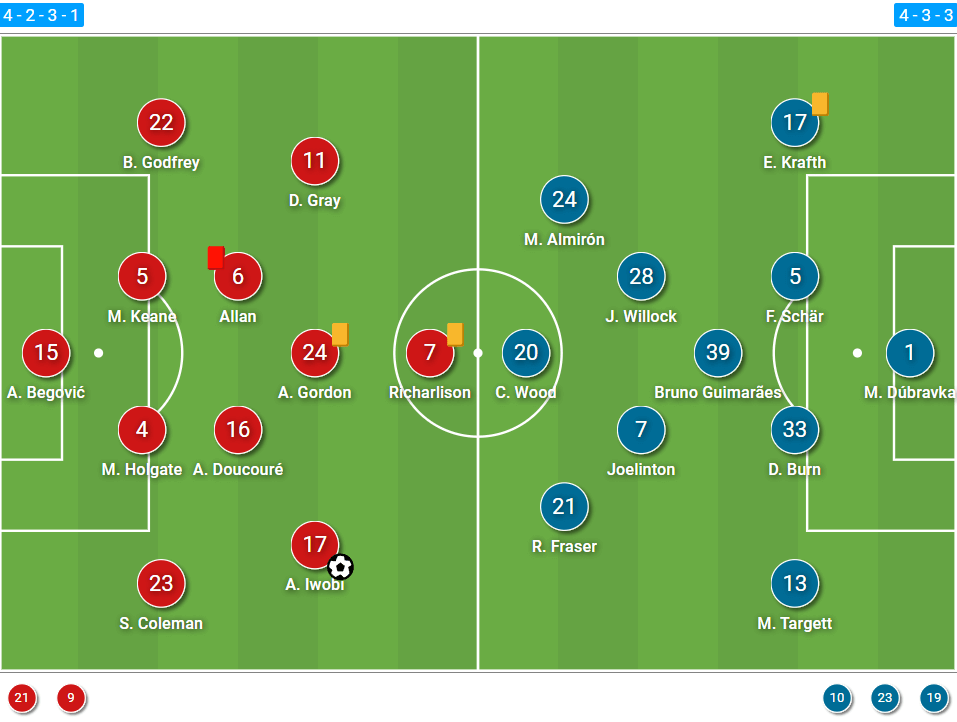
In an attempt to stave off the possibility of a drop down to the Championship, Lampard began experimenting with a 3-4-3 formation in recent weeks. Nonetheless, Sunday’s harrowing home defeat to Wolverhampton Wanderers forced him to reconsider.
The former Derby County boss set Everton up in a 4-2-3-1 against Newcastle in the hope of being able to get more out of the players at his disposal. There was a reshuffling of the pack too as the young manager brought three changes into the lineup.
Asmir Begovic, Allan and Alex Iwobi were all handed starts in place of the injured Jordan Pickford and Donny van de Beek who were absent through injury, as well as Vitaliy Mykolenko who dropped to the bench.
To negate Chelsea’s front five in possession last week, Eddie Howe restructured his side into a 5-4-1 for Sunday’s trip to Stamford Bridge but reverted to his preferred 4-3-3 against Everton.
Four changes were made by the visitors in contrast to their previous league outing. Jacob Murphy, Sean Longstaff, Jamal Lascelles, and Javi Manquillo all dropped out of the side in place of Ryan Fraser, Joe Willock, Joelinton and Emil Krafth to complete the 4-3-3 reversion.
Everton allowing easy build-up play
There was a lot of speed in Newcastle’s attacking department during this match. With Fraser and Miguel Almiron on the flanks, as well as Joelinton and Willock making runs in behind from midfield, Everton could not push too high up the pitch.
Lampard still wanted his players to press Newcastle when they were in deeper areas but was not willing to commit the entire block higher by moving the defensive line up in order to quash the space between the lines so as to avoid getting hit by direct balls in behind.
Quite often, this type of pressing is risky as it can lead to breakdowns easily since there can be a lot of space to either play over or around the press. For instance:
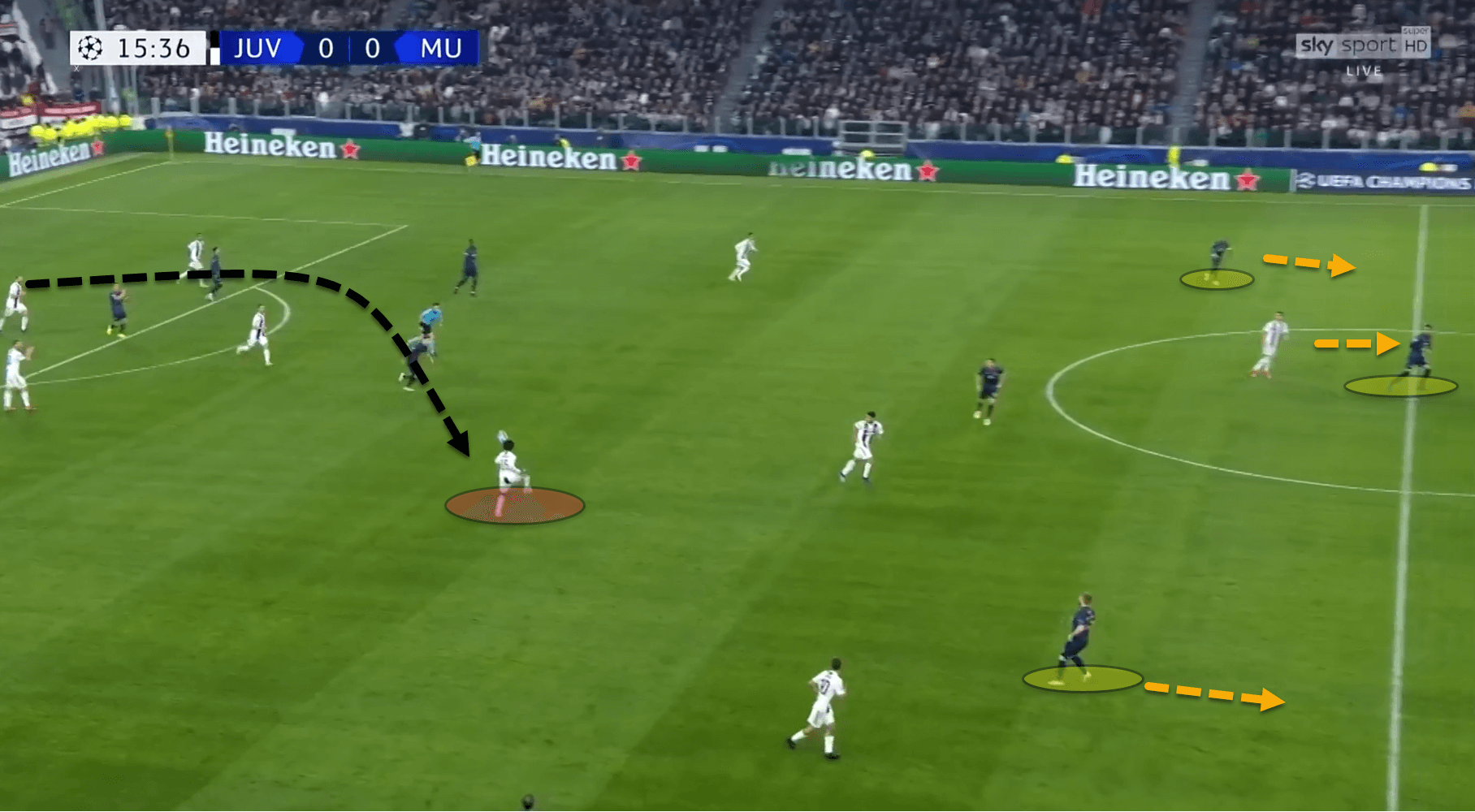
Like Juventus in this example against Manchester United from back in 2018, Newcastle were able to take advantage of Everton’s uncoordinated pressing.
However, firstly, it’s important to analyse exactly how Everton tried to press their opponents in this game before observing how the visitors were able to break it down with aplomb.
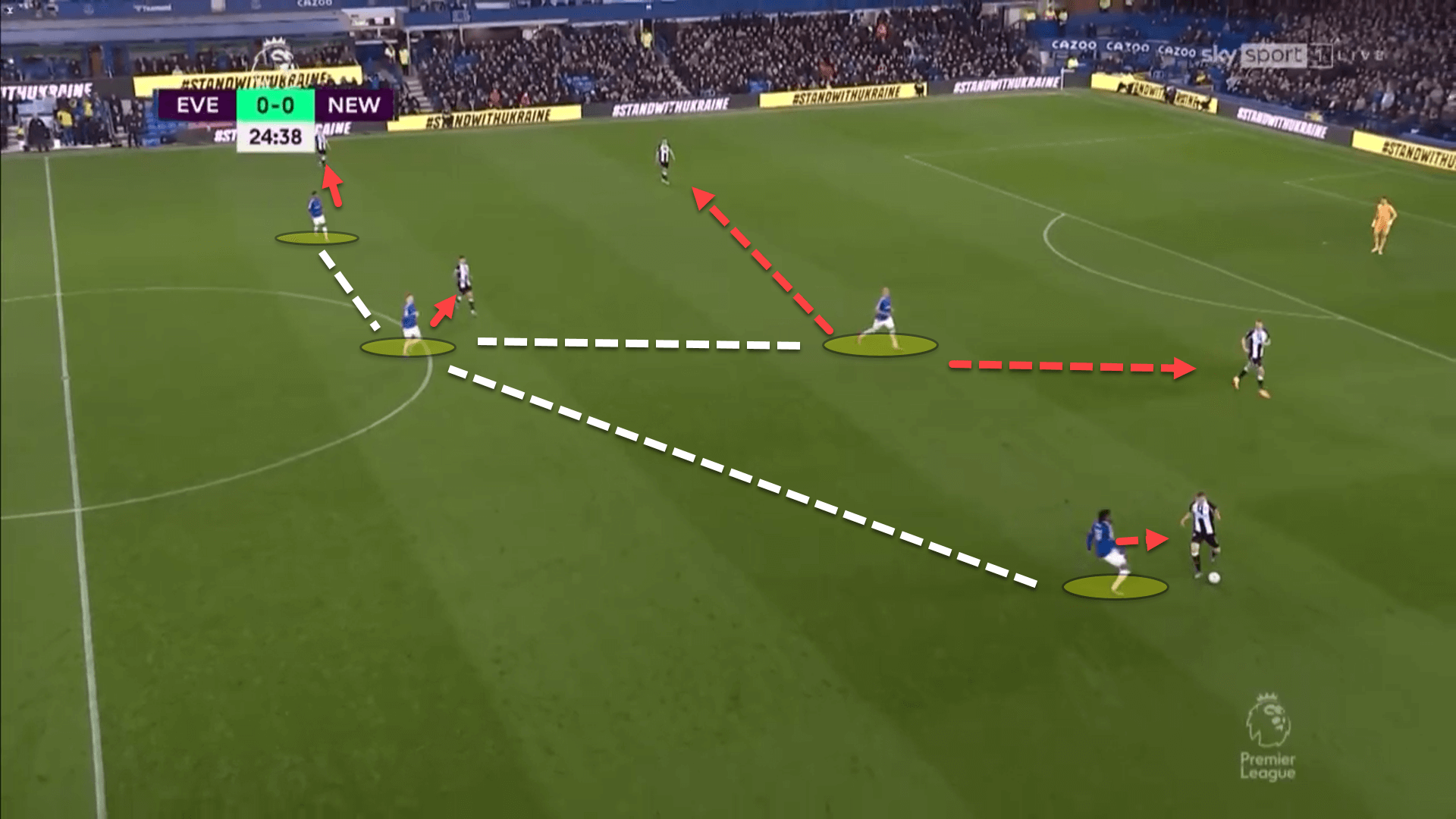
In the build-up phase, as they looked to progress through Everton’s initial pressure, Newcastle would build with their fullbacks low, as is portrayed in this image.
Subsequently, given the Toffees were set up in a 4-2-3-1, they could largely go man-for-man in these situations. The winger pressed the fullbacks and Anthony Gordon, who was operating as the number ‘10’, would sit on Bruno Guimarães, Newcastle’s single pivot.
Richarlison’s role was slightly more difficult as the Brazilian forward was tasked with pressing both centre-backs, but ensuring that when he applied pressure to one, he shaped his run to block off the angle to the other.
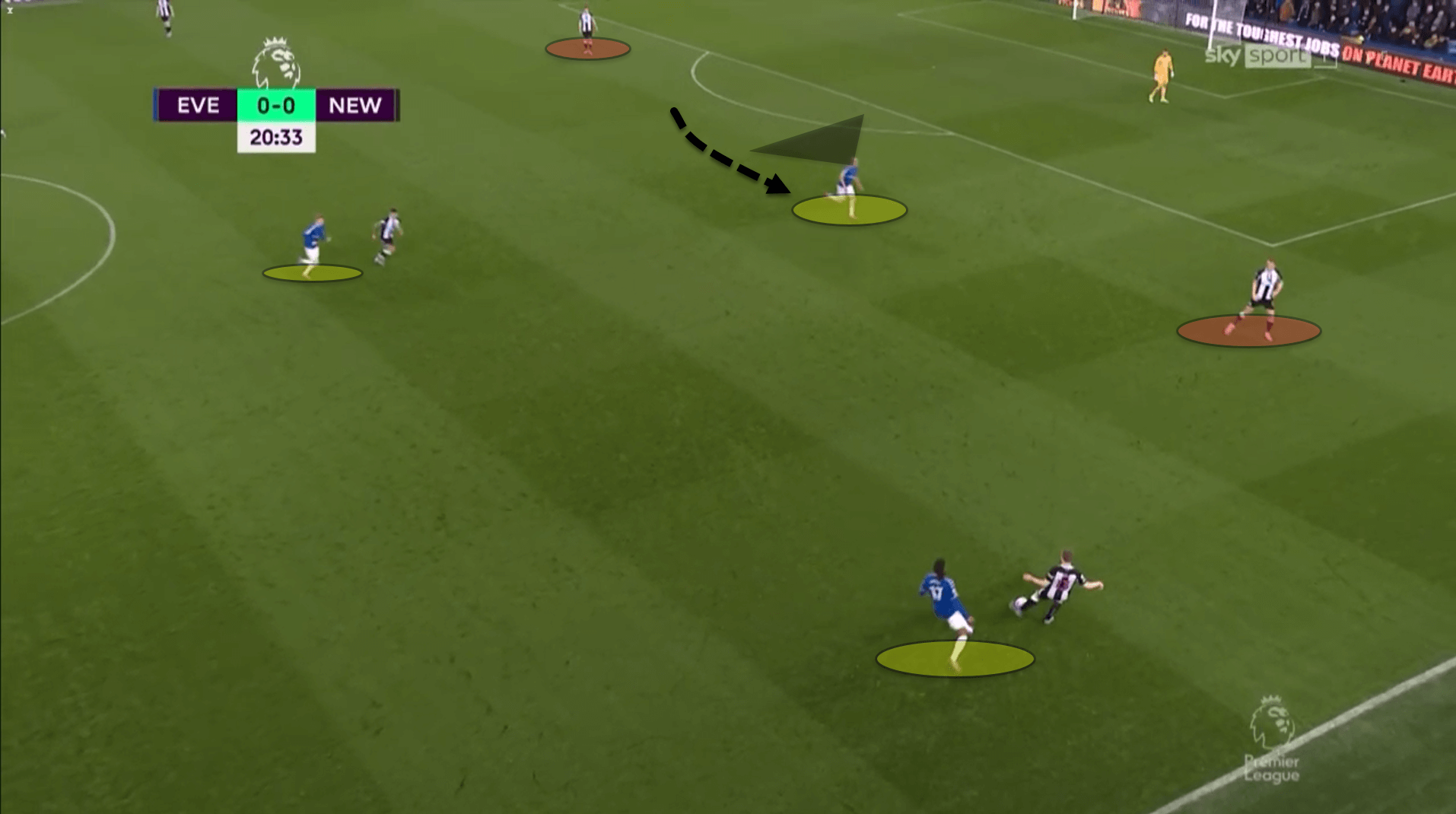
As the two systems matched up pretty well in midfield, Everton could go man-oriented in this area with their double-pivot of Allan and Abdoulaye Doucoure marking Joelinton and Willock in the halfspaces and central corridors.
On paper, this seemed like a solid tactical plan to negate Newcastle’s ability to progress the ball forward through the thirds. However, practically speaking, the Magpies quickly adjusted to their opponent’s game plan and found quite an easy solution to the problem posed.
Almiron would stay high and wide on the right flank and would pin back Everton’s left-back Ben Godfrey. This would prevent the defender from pushing forward to join the press. Next, Willock would drop out to the wide area to receive the ball from Krafth at right-back.
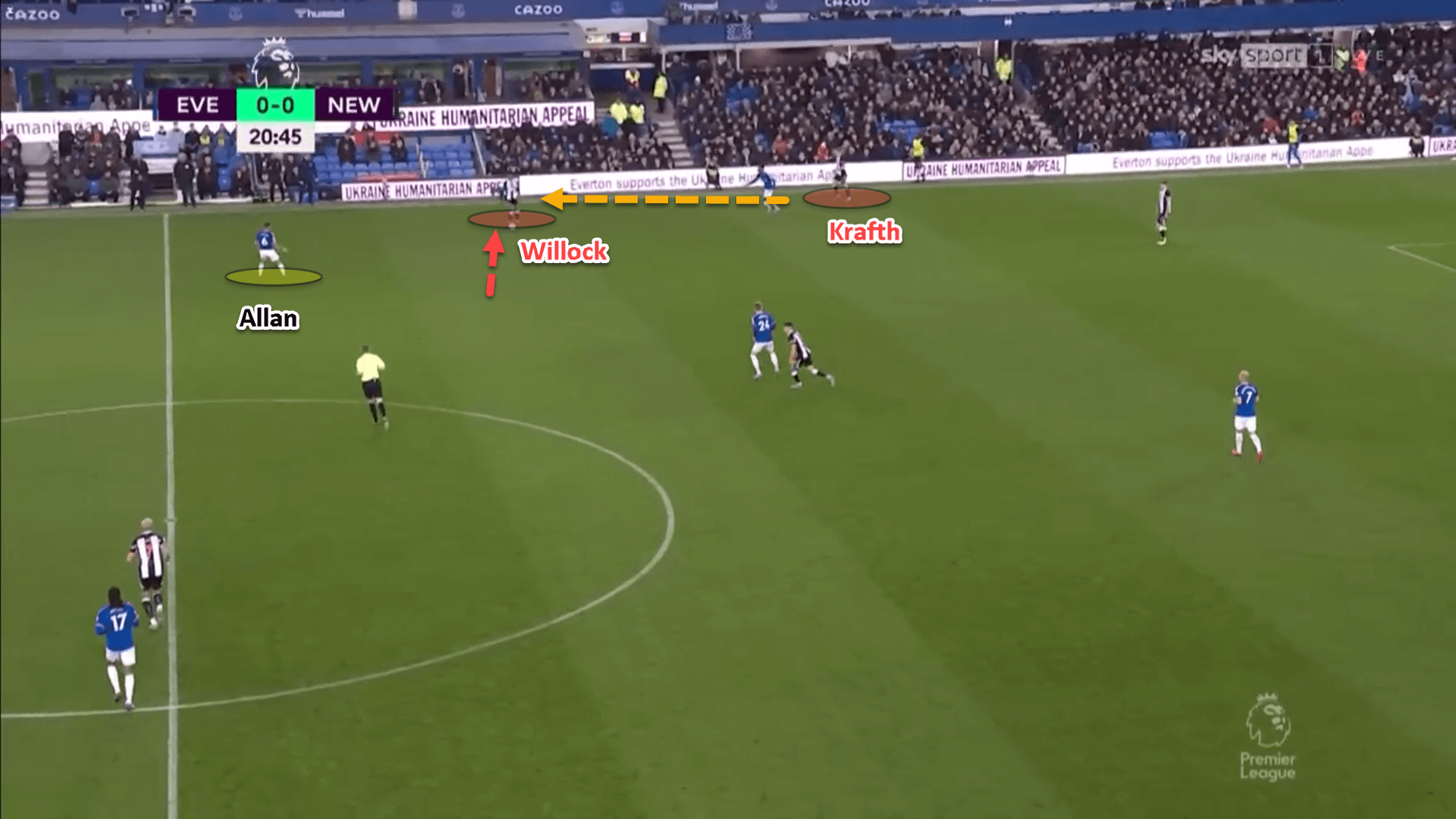
The former Arsenal midfielder was able to move out to these spaces and receive the ball completely unscathed before advancing further forward. There was a complete breakdown from Everton’s pressing structure in the first half.
In fact, the pressing became rather tedious. It wasn’t working and Newcastle were easily breaking through their pressure. Perhaps it would have made more sense for the home side to drop off into a deep defensive block from the off instead of allowing the Magpies to take several players out of the game.
Allan couldn’t move out to close Willock down because he would be leaving a massive gap in the central area for the visitors to exploit. Sometimes, Willock would even drop deep in a more central space which would cause Allan to follow him and be dragged out of position.
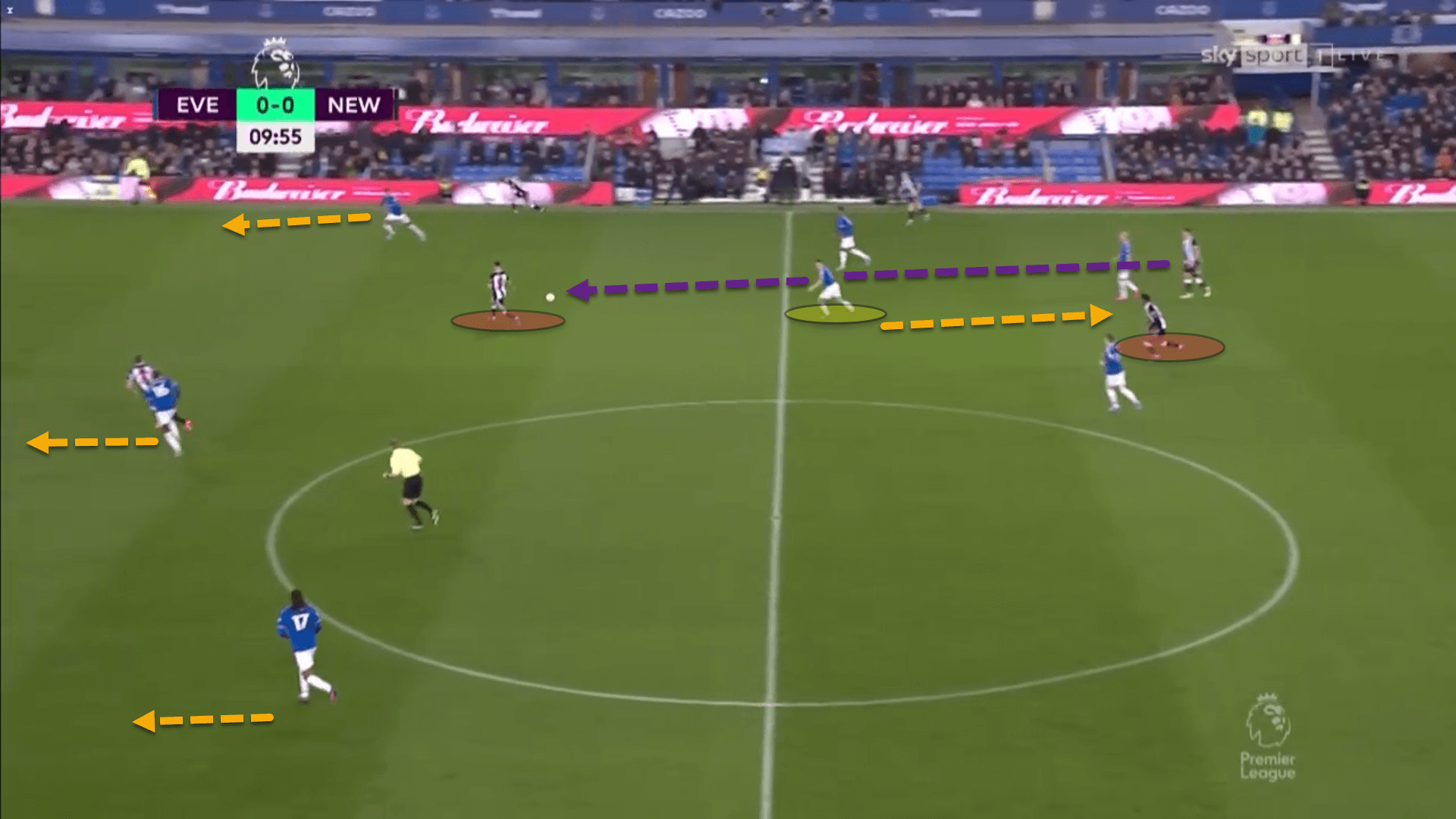
As Everton’s lines were quite distanced from each other, the backline was unable to step up to try and nip the ball and so when scenarios like this arose, they were forced to backpedal quickly in order to reduce the space in front of the goalkeeper.
A cooperative pressing scheme is the backbone of any good side. Everton need to quickly work on their structure on the training pitch or else stop pressing high completely.
Everton being unable to transition
Everton’s game plan was to defend in a block and look to hit Newcastle on the break using the pace in their forward line. Or at least it turned out to be this way given that Everton held just 38 percent of the share of possession in the first half.
Players like Richarlison, Gordon, Demarai Gray and Iwobi are all very quick and can hurt a backline with their speed.
There were a couple of times in the match that Everton were able to nick possession while sitting in a low block and transition quickly with their four frontmen.
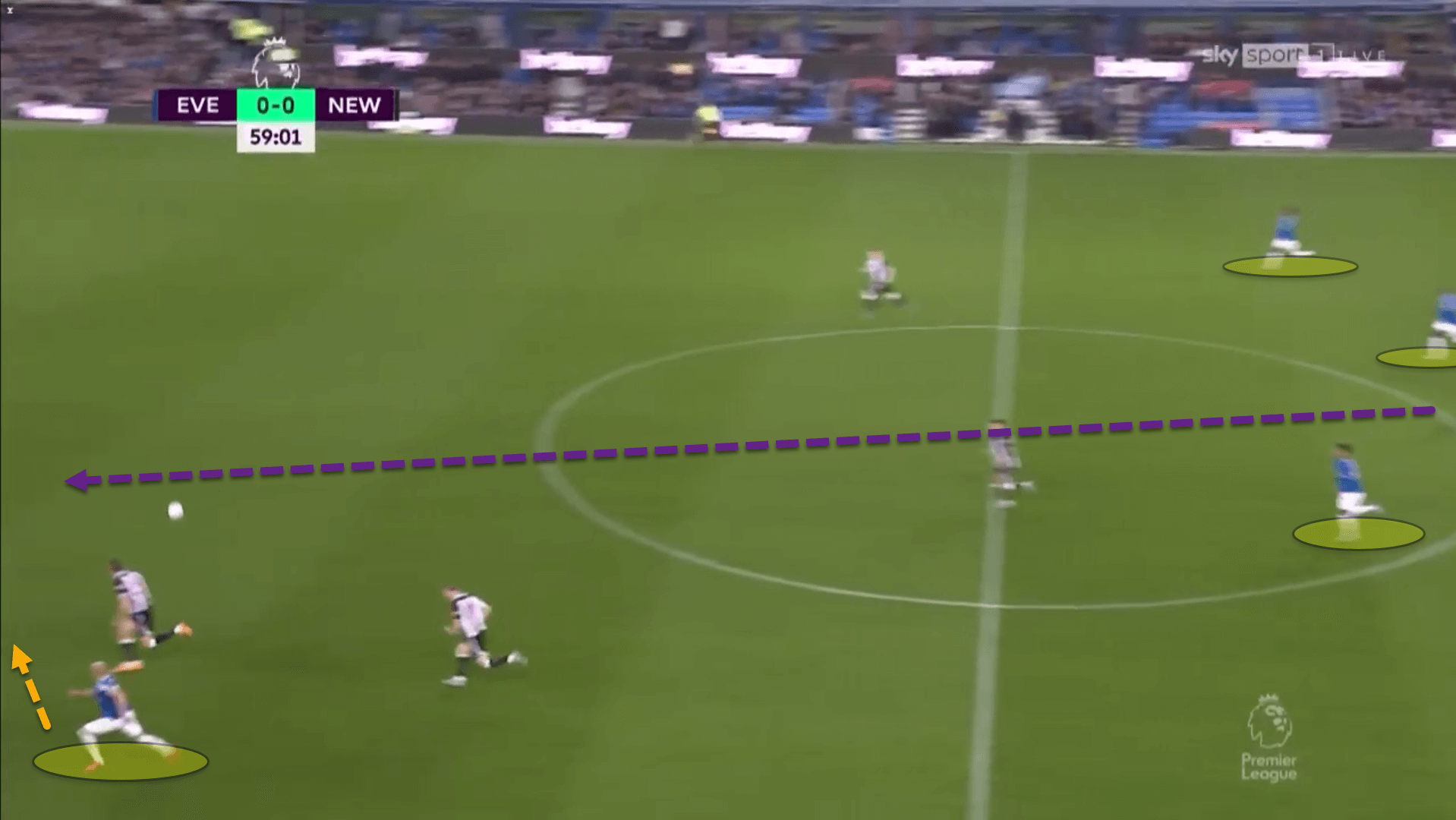
However, as can be seen from this image, it was mainly Richarlison who was being hit on the break, but the ex-Watford striker was constantly left isolated up front which caused the counterattacks to break down more often than not.
The issue Everton were having was that they were sitting so deep on the pitch for the most part while defending that it became increasingly difficult to formulate an effective counterattack. Generally, Richarlison was the only player forward.
In the modern game, because of innovative rest defence structures and phenomena of counterpressing, attacking transitions from deep areas are excessively difficult.
To analyse why the Toffees struggled to counterattack against the Magpies, it’s important to observe Newcastle’s structure in possession.
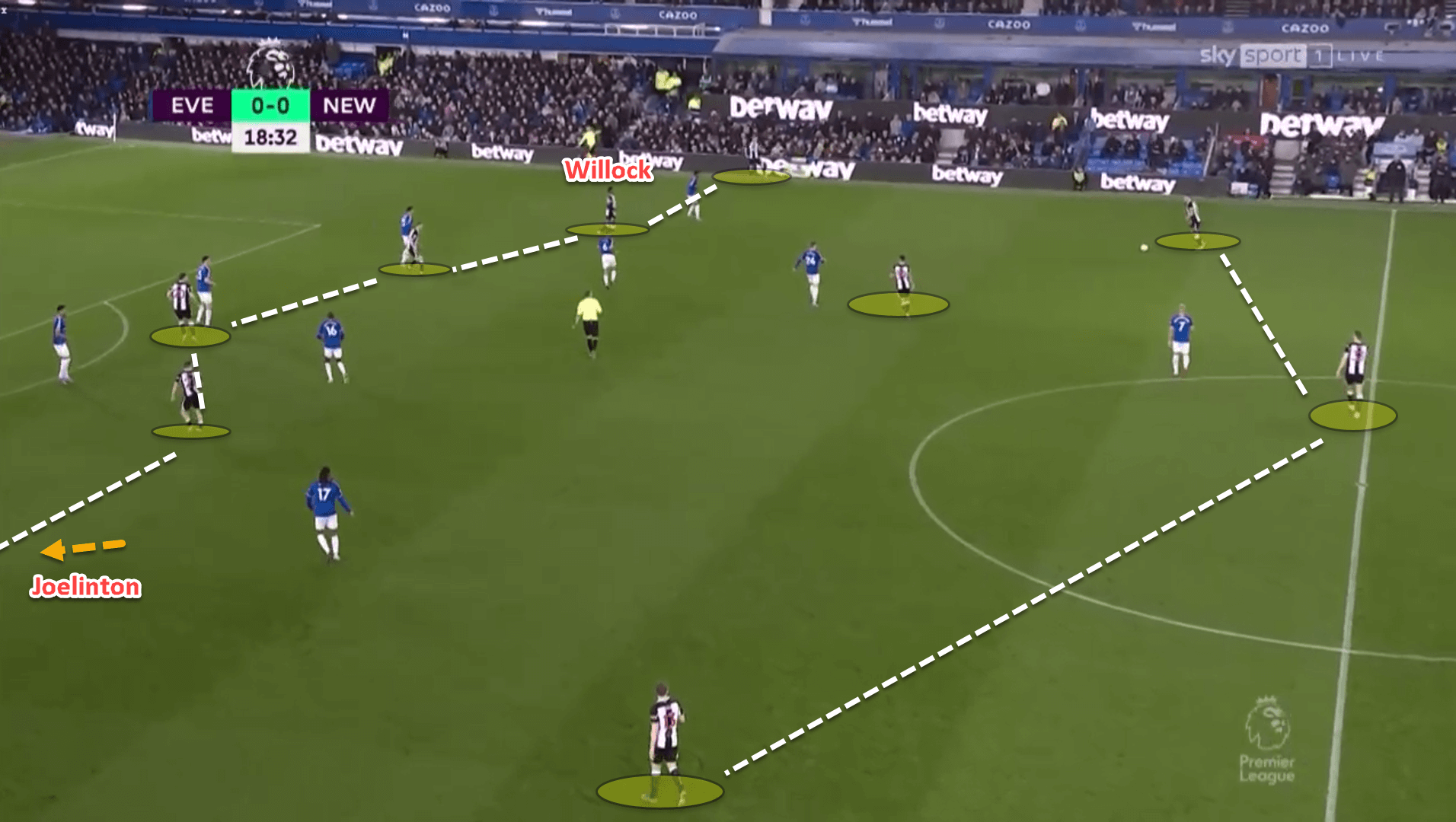
Newcastle generally set themselves up in a 3-1-6 formation in possession. One of the fullbacks would stay back and tuck inside to create a back three while the other advanced further up the pitch. Typically Krafth was the one who remained back, but in this instance it was Targett.
More importantly, the two advanced central midfielders would push up between the lines, joining the front three in the higher areas in order to break down Everton’s low block. As Willock and Joelinton are both attack-minded players, they could perform these duties well.
Howe instructed these two ‘8’s to make runs in the seams to try and receive the ball, which are the channels between the fullbacks and centre-backs. When this occurred, Allan and Doucoure were forced to follow their men deep.
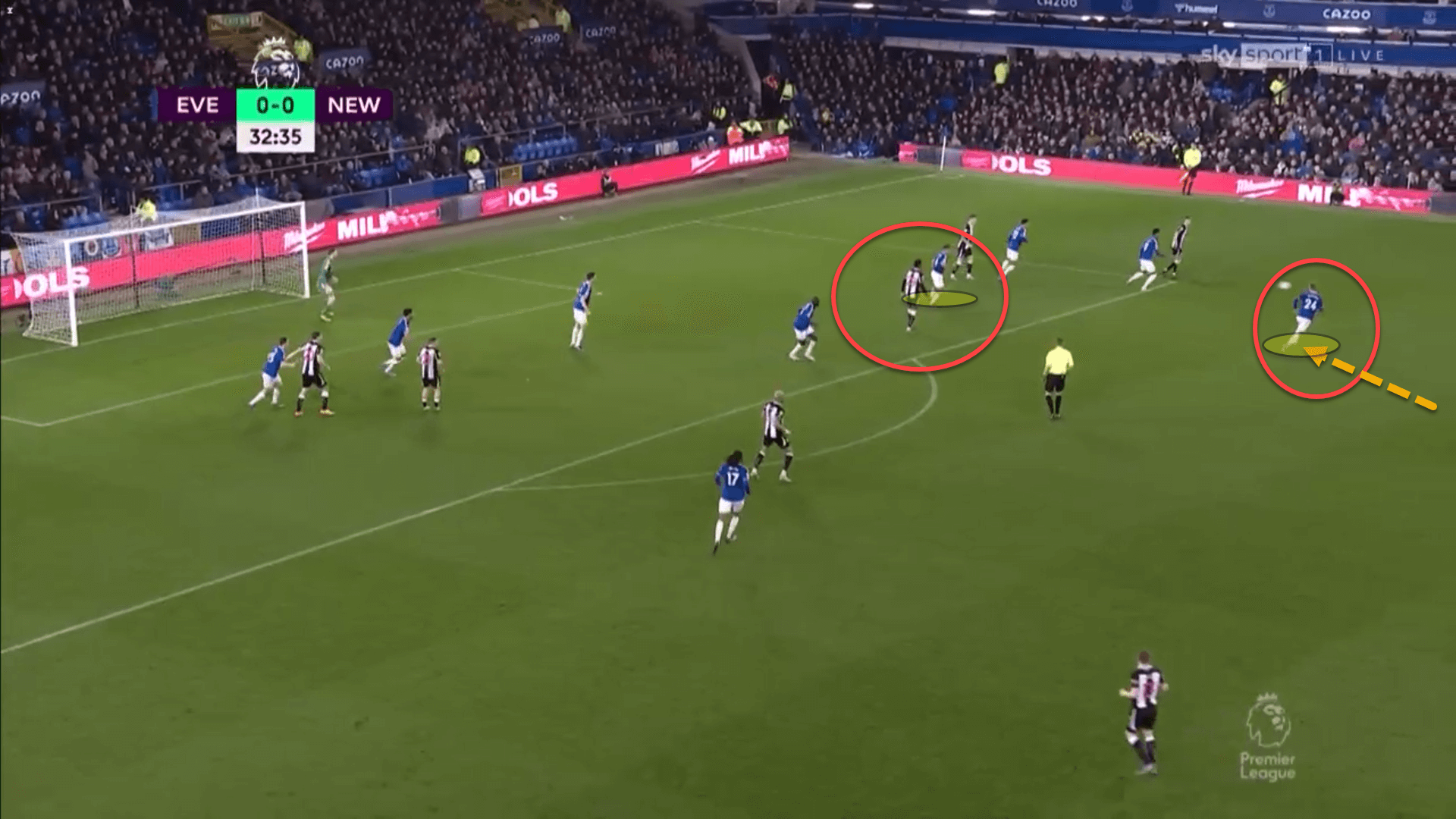
For instance, here, Allan had to drop into the backline, creating a temporary back five so he could deal with the threat of Willock who had positioned himself in this space to receive the ball.
Unfortunately, this caused Gordon to have to drop deeper and cover the space in front of the defence which was vacated by Allan. The issue this created was that now there was quite a substantial distance between Gordon and Richarlison, meaning it was next to impossible to create a coherent counterattack.
The plan was to leave Gordon and Richarlison higher on the field which allowed Everton to have two men forward when possession was won but the positioning of Newcastle’s midfielders negated this threat and Richarlison was usually left to mindlessly chase loose balls up to him with next to no support.
Everton’s attacking approach
Everton were without Pickford for this game. The English goalkeeper has been going through some turbulent form recently but is still a solid player with the ball at his feet, unlike his replacement, Begovic.
The Bosnian keeper put in a fine shift overall, but Lampard was forced to change the approach of his side by hitting longer passes to bypass Newcastle’s pressure as opposed to trying to play their way through the press.
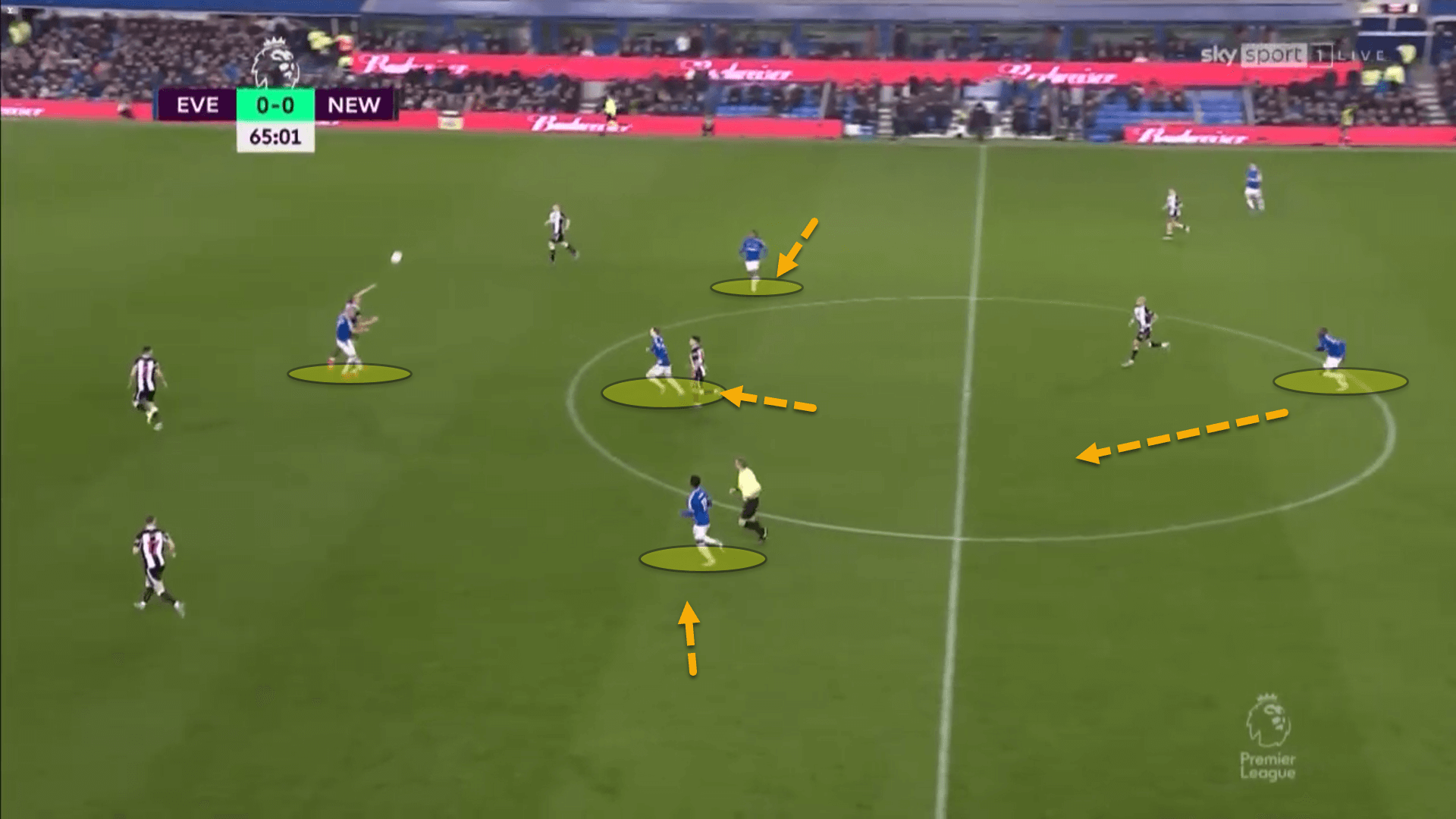
Everton’s passing map from the game told the story of how the side played whilst in possession. Their passing network was extremely weak but the strongest link came from Begovic playing long to Richarlison.
Going direct to the Brazil international was a constant feature in Everton’s tactical plan during settled attacks in order to progress play. This actually worked rather well. Richarlison is solid in the air and his ability to hold up play allowed the other players to get up to him to win the second ball and retain possession in higher areas.
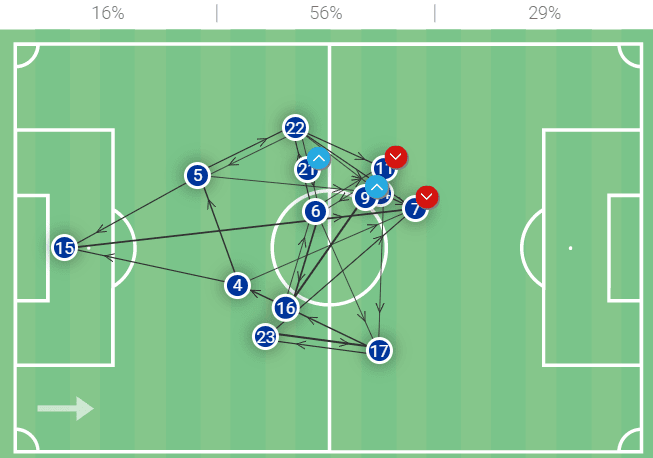
Against Newcastle on Thursday, Everton played 52 long balls in total, winning a total of 59.09 percent which is very high given the uncertainty around such passes. The side’s average this season in all competitions has been 44.84 per 90, meaning the Toffees exceeded their usual number of long passes by quite a significant amount.
Direct balls up to Richarlison caused Everton to be able to retain the ball higher up the pitch and form a sustained attack.
When attempting to break Newcastle down through positional play, Everton would do so through the wide areas, creating overloads on the flanks to put crosses into the area.
In this vital and vitriolic relegation clash, Everton had a total of 22 positional attacks. Only four ended in a shot on goal which accumulated an xG of 0.44.
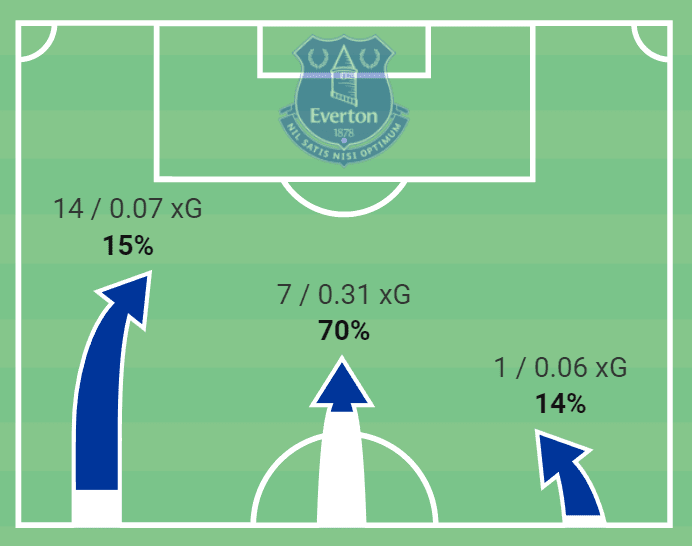
Whilst in these areas, Everton would look to create an overload with the ball-near fullback, winger and Gordon as the number ‘10’ whilst Doucoure would push high up the pitch, in between the lines, to give an extra attacking option to the side due to his box-to-box qualities.
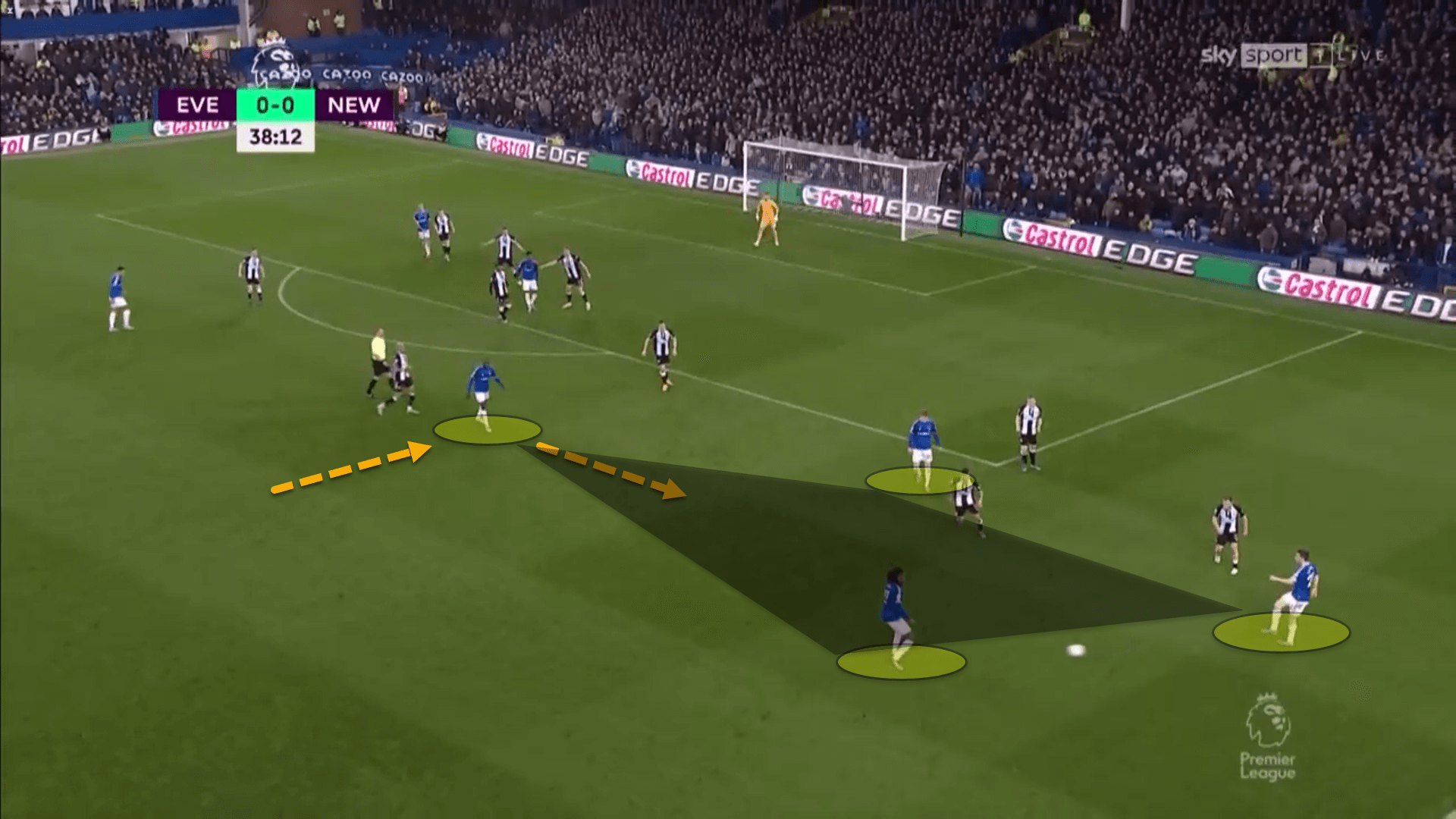
This was a very risky tactical set-up by Lampard because he was leaving just Allan back to protect the defensive line in case Newcastle won the ball and looked to transition.
The issue with this is that Allan not the most efficient player at doing so alone and has a tendency to give away fouls once a team gets past him on the break. Against Southampton a few weeks back, the Toffees faced the exact same problem when van de Beek advanced to higher areas of the pitch, leaving the former Napoli man to sit back to protect the defence – something he did poorly in that fixture.
If you watched the game, you already know where this is headed. Yes, Allan was sent off, albeit controversially, for a poor challenge while trying to stop Newcastle from breaking away at lightning speed.
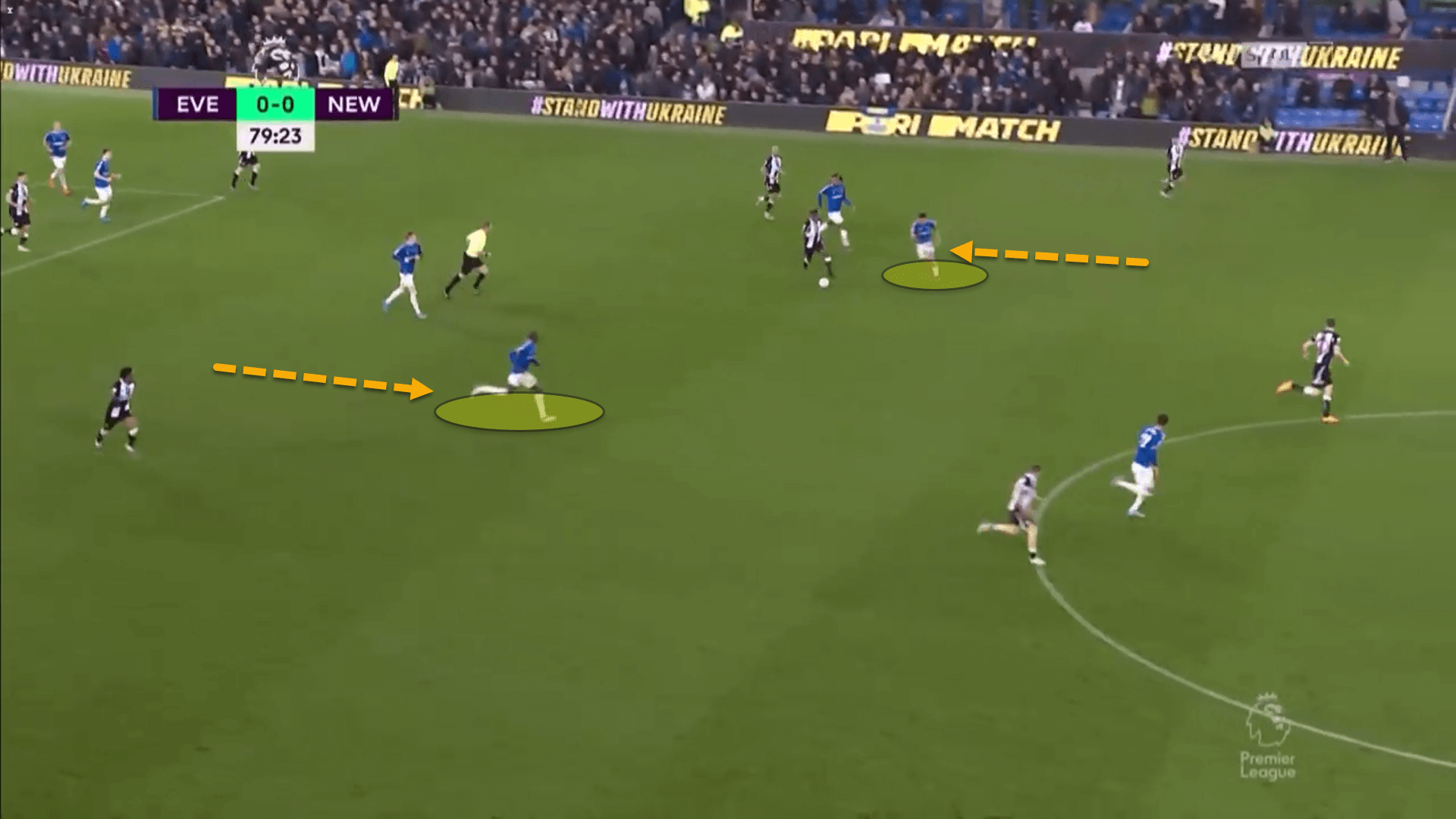
Howe’s men were on a breakaway after Everton had a dangerous attack in the final third. Allan, who was sitting back as the only player defending the space in front of the centre-backs, made a rash challenge on Allan Saint-Maximin.
The player can certainly be blamed for making such a poor decision in a vital moment but having him protect your backline on his own is like trying to stop bullets with a wooden shield.
Ultimately, Lampard is stuck for choice given the personnel available to him at the minute because of injuries and a desperate need to strengthen in the summer transfer window. Perhaps his best option right now is to keep both of the pivot players back. This would weaken their attacking possibilities but would certainly strengthen them in defensive transitions.
Conclusion
Thursday’s bout was an extraordinary three points for the Merseyside strugglers. Iwobi’s late goal from some lovely one-two play with Dominic Calvert-Lewin gave the home side the victory and saved the team from further despair.
However, objectively, the scoreline probably flattered to deceive a little. The end result is the only statistic that matters at full time, but Lampard will undoubtedly be analysing the game back vigilantly, looking to solve the issues that continue to rear their ugly head.






Comments